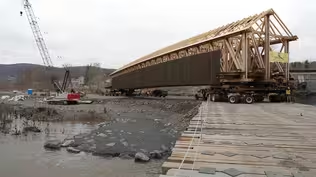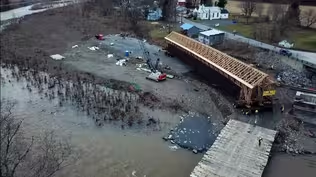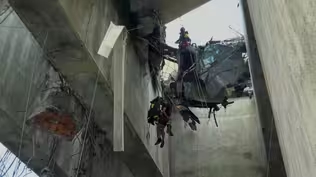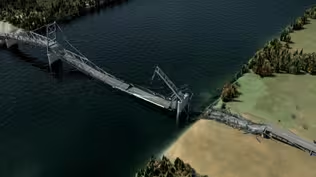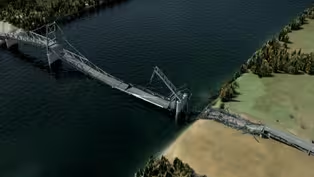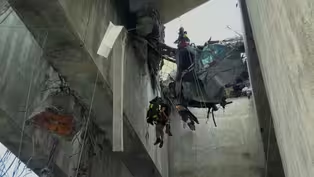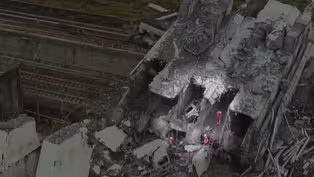
Why Bridges Collapse
Season 46 Episode 18 | 53m 25sVideo has Closed Captions
Can new engineering techniques help prevent deadly bridge collapses?
In 2018, Italy’s Morandi Bridge collapsed, tragically killing 43 people. For 50 years, the iconic bridge had withstood the elements—and stress from ever-increasing traffic. What went wrong that fateful day? And how can new engineering technology protect bridge infrastructure to prevent such tragic failures in the future?
Problems playing video? | Closed Captioning Feedback
Problems playing video? | Closed Captioning Feedback
National Corporate funding for NOVA is provided by Carlisle Companies and Viking Cruises. Major funding for NOVA is provided by the NOVA Science Trust, the Corporation for Public Broadcasting, and PBS viewers.

Why Bridges Collapse
Season 46 Episode 18 | 53m 25sVideo has Closed Captions
In 2018, Italy’s Morandi Bridge collapsed, tragically killing 43 people. For 50 years, the iconic bridge had withstood the elements—and stress from ever-increasing traffic. What went wrong that fateful day? And how can new engineering technology protect bridge infrastructure to prevent such tragic failures in the future?
Problems playing video? | Closed Captioning Feedback
How to Watch NOVA
NOVA is available to stream on pbs.org and the free PBS App, available on iPhone, Apple TV, Android TV, Android smartphones, Amazon Fire TV, Amazon Fire Tablet, Roku, Samsung Smart TV, and Vizio.
Buy Now

NOVA Labs
NOVA Labs is a free digital platform that engages teens and lifelong learners in games and interactives that foster authentic scientific exploration. Participants take part in real-world investigations by visualizing, analyzing, and playing with the same data that scientists use.Providing Support for PBS.org
Learn Moreabout PBS online sponsorship♪ ♪ NARRATOR: For more than 50 years, the Polcevera Bridge stood as a landmark in the city of Genoa.
CAMILLO NUTI: It was a masterpiece, and everybody knows it was a masterpiece.
NARRATOR: It was one of the most famous bridges in Italy.
TULLIA IORI: It was the bridge of the future.
The bridge was really beautiful.
NARRATOR: But on August 14, 2018, disaster strikes.
MAN (yelling in Italian, repeating): NARRATOR: A huge 800-foot section of the bridge, carrying four lanes of traffic, collapses.
(people calling in background) NARRATOR: 27 vehicles plummet into the valley below.
43 people die.
It is one of the worst road bridge collapses in Europe for more than a century.
And yet there was no warning.
Why did this seemingly sound bridge suddenly fall down?
And is anyone to blame?
In the last ten years, more than 60 bridges have collapsed around the world.
How many more are about to give way?
In the United States, over 47,000 bridges are classified as structurally deficient.
We have had over two dozen bridges fail in the United States since 2000.
NARRATOR: Can engineers guarantee the safety of our aging bridges before it is too late?
"Why Bridges Collapse," right now on "NOVA."
♪ ♪ ♪ ♪ NARRATOR: Genoa.
One of Italy's busiest ports.
Over 6,000 ships a year carry 54 million tons of cargo through here, nearly all of it placed on trucks.
♪ ♪ The trucks fan out in all directions, but many end up on this highway, the E80.
♪ ♪ It's a critical link between the South of France and Rome, shuttling more than 70,000 cars and trucks past Genoa every day.
(car engine humming) August 14, 2018.
Firefighter Davide Capello drives his S.U.V.
along route E80, heading east towards Genoa.
CAPELLO (speaking Italian): (Radio announcer speaking Italian) CAPELLO: (radio announcer continues) CAPELLO: NARRATOR: Gianluca Ardini, a foreman for a furniture company, heads in the opposite direction along the E80 highway.
ARDINI (speaking Italian): ♪ ♪ NARRATOR: Both Gianluca and Davide are heading towards the Polcevera Bridge, locally known as the Morandi Bridge.
This iconic landmark connects the two sides of Genoa.
At 11:36 a.m., the world in front of them begins to come apart.
(speaking Italian): MAN (yelling in Italian, repeating): (speaking Italian): CAPELLO (speaking Italian): NARRATOR: A massive 800-foot section of the bridge, carrying four lanes of traffic, collapses.
Gianluca's truck plummets 100 feet.
(speaking Italian): ♪ ♪ ♪ ♪ NARRATOR: 27 vehicles fall with the bridge.
This is Davide Capello's S.U.V.
It falls 130 feet and lands inside a cavity formed by a section of the bridge.
(speaking Italian): NARRATOR: Across from Davide's car, trapped inside the remains of the collapsed bridge tower, rescuers make a shocking discovery.
Hanging inside this truck is Gianluca Ardini.
ARDINI (speaking Italian): NARRATOR: Firefighters begin the precarious job of rescuing him from the mangled cab.
(people talking in background) NARRATOR: It takes 40 minutes to cut Gianluca free and carry him to safety.
400 firefighters from all over Italy arrive with specialized equipment most often used to rescue people from earthquakes.
Sniffer dogs search for survivors.
♪ ♪ After four days, firefighters finally recover the last body.
♪ ♪ The collapse of the Polcevera Bridge kills 43 people and injures 15.
It's far and away Italy's worst road bridge disaster.
♪ ♪ The catastrophe sounds a chilling alarm.
Engineers around the world want answers-- why was there no warning?
What caused the sudden collapse?
And most important, how many other bridges are at risk?
The stakes are huge.
If the bridge failed due to age, that could mean disaster for thousands of other bridges built at the same time.
♪ ♪ All products of a highway construction boom that began more than a half a century ago.
Across many countries, the Second World War destroyed thousands of roads and bridges.
In the years that followed, engineers set about rebuilding the bridges, while also constructing new, super-fast highways.
This was the dawn of the golden age of the car.
And nowhere more so than in the United States.
♪ ♪ In 1956, President Eisenhower signed the Federal Aid Highway Act to create 41,000 miles of interstate highways.
FILM NARRATOR: As far as the eye can see, in almost every city, concrete and asphalt are changing the patterns of land and land use.
Soon, traffic will flow smoothly in, around, and between every major city and town in America.
NARRATOR: Today in America, just as in Europe, many of these concrete bridges are growing old.
About two-thirds of our interstate highway system bridges were built in either the 1960s or 1970s, so a number of those structures are coming to the end of what's called their useful design life.
NARRATOR: The United States has more than 600,000 road bridges.
Over 47,000 of them are classified with the term "structurally deficient."
BLACK: What that means is that when the bridge is inspected, one of the key structural elements is rated in poor or worse condition.
So it means they're bridges that need to be repaired.
♪ ♪ NARRATOR: Are these bridges, located all across America and the world, ticking time bombs?
And particularly, if they share the same faults as the Polcevera Bridge in Genoa, then lives could be at stake.
♪ ♪ Within hours of the disaster in Italy, the site becomes the focus of a major investigation.
Engineers need to find out what caused the bridge to collapse.
Camillo Nuti is an independent engineer who worked on the Italian government inquiry into the disaster.
One should be very cautious before removing anything.
Obviously, you have to remove the debris, but then be very careful, because you have to take the pieces, then try to understand if there was failure somewhere.
If there was failure, you should find those pieces broken.
NARRATOR: Finding those pieces is a daunting challenge.
Sifting thousands of tons of debris, investigators need to identify the single part of the bridge that failed and triggered the disaster.
They move any suspect pieces to this secure warehouse.
The operation will take months, so at the same time, they pursue a parallel line of inquiry.
♪ ♪ They turn their attention to the way the bridge was built and its original design.
♪ ♪ The planning of the Polcevera Bridge began in the early 1960s.
(speaking Italian): NARRATOR: Its designer, Riccardo Morandi, was a star engineer of Italy's postwar reconstruction boom.
His work included astonishing modern structures, like this aircraft hangar in Rome, and dozens of bridges.
IORI: He was the best bridge design engineer in Italy.
There is no Italian engineer who built what Morandi built.
NARRATOR: To construct the Polcevera Bridge in Genoa, Morandi faced a huge challenge.
The bridge had to span the Polcevera River, multiple railway lines, and four apartment buildings.
His plan was to build three enormous trestles, each with a tower nearly 300 feet high.
Then, to hold up the road deck, he would use giant supports called cable stays, made of steel and concrete.
When complete, the vast bridge would be over half a mile long.
♪ ♪ To build it, Morandi used a relatively new method of construction, one that he had helped develop.
Before this time, most concrete bridges used simple steel reinforcement.
But by stretching steel cables threaded through hollow guides in the concrete, engineers found they could build longer spans.
The tension in the wires acted to compress the concrete, making it less likely to bend and crack.
This was called prestressed concrete, and Morandi relied on it for the Polcevera Bridge.
In his design, he does something radical.
In most cable-stay bridges, the road deck is supported by many cables, spread out across the span.
But to support his deck, Morandi bunches all the cables together to create massive cable stays, each one made of 52 steel cables wrapped in concrete to protect them from corrosion.
NUTI: The technique was a novelty.
He put just four cables for each pier, but they were incredibly strong cables.
♪ ♪ NARRATOR: After four years' construction, in 1967, Italy's president opened the bridge to an enthusiastic reception.
IORI: The Morandi Bridge was the most important bridge in Italy.
The biggest, the more beautiful, the most...
The most famous.
Absolutely.
NUTI: It was a masterpiece, and everybody knows it was a masterpiece.
♪ ♪ NARRATOR: But 50 years later, the bridge fails catastrophically.
Did Morandi's pioneering design play any role in causing it to collapse?
♪ ♪ To find out what caused the disaster, investigators need to discover which part of the bridge failed first.
They look for CCTV cameras in the area that would have recorded the moment the bridge collapsed.
♪ ♪ Rain obscures the view in almost all the cameras.
But in this scrapyard, they find a video that captures the disaster from beginning to end.
The recording is part of an ongoing criminal investigation, and is impounded.
Francesco Cozzi is the state's prosecutor in charge of the criminal investigation.
COZZI (speaking Italian): NARRATOR: Sources familiar with what happened have provided clues that allow a reconstruction of the probable sequence of the bridge collapse.
At just after 11:36 a.m., something happened that caused the southeast cable stay on pylon nine to break.
Unsupported, that side of the road deck sags.
This unbalances the whole structure, and increases the load on other components beyond their breaking points.
This sends the road deck plummeting to the ground, and causes the giant tower to collapse.
♪ ♪ It looked like the unthinkable had happened.
Some of the steel cables Morandi had embedded in concrete to protect them from corroding had snapped.
But why?
♪ ♪ The bridge had stood firm for over half a century, carrying millions of travelers.
So what caused it to fail the very moment it did?
♪ ♪ Like most road bridges built during the building boom of the 1960s and '70s, the Polcevera Bridge had been experiencing steadily rising traffic loads.
By 2009, it carried four times as many vehicles as 30 years earlier.
Over 25 million vehicles crossed it each year.
Could the weight of traffic on the bridge have brought it down?
Like all major bridges in Italy, the Polcevera Bridge was designed to carry the load of a convoy of heavy military vehicles.
This meant it should have been able to carry the weight of modern traffic.
But a small error in design or construction can have catastrophic consequences, as happened to this bridge in the United States.
On August 1, 2007, Kelly Kahle was driving towards the I-35W bridge in Minneapolis.
KAHLE: It's rush-hour traffic, 6:00.
I'm going north, and we get right on the interstate.
All of a sudden, there's a rumbling.
And then all of a sudden, the bridge in front of me, far in front of me, looks like it rose up.
And it almost looked like it was oscillating.
Looking back on it, I can see that we were on a point that was failing, and we were starting to fall.
NARRATOR: This is Kelly's car.
It narrowly escaped plunging into the river.
I climbed onto the hood of the car, and skimmied onto this concrete island, and just looking around and seeing other people kind of getting their wits about them.
NARRATOR: 111 vehicles were on the bridge when it gave way.
13 people died.
145 were injured.
When investigators reassemble the pieces of the collapsed bridge, their attention focuses on a part known as a gusset plate.
Gusset plates are flat plates of steel that hold the girders of a truss bridge together.
The key pieces of the I-35W bridge have been preserved.
These pieces are all connected to the single gusset plate that failed when the bridge collapsed.
During the collapse, this folded in on itself and was completely mangled by the weight coming down on top of it.
NARRATOR: At the time of the collapse, workers were preparing to re-lay the road.
Trucks had dumped piles of sand and gravel on the closed lanes.
REIERSON: There were 800,000 pounds of construction equipment on the top of the bridge, as well as over 160 people in cars, because it was the very end of rush hour that day.
NARRATOR: That combined load proves too much for one of gusset plates.
REIERSON: The gusset plate split along a line of rivets.
You can see that it's completely torn apart.
NARRATOR: The bridge was overloaded.
But its designers had also made a mistake.
The gusset plate was only a half an inch thick, and it should have been one inch.
So it should have been double the thickness that it, that it was, and that's what led to the failure.
♪ ♪ NARRATOR: Did Genoa's Polcevera Bridge collapse because of a similar fault-- a failure to make it strong enough to carry heavy loads?
When Morandi planned the bridge, he designed it to support a lot of weight.
NUTI: The ideas of Morandi was, let's build a bridge with very, very strong cables to where it's overdesigned, very much overdesigned.
So the design was incredibly safe for the time.
NARRATOR: When the bridge was built, the cable stays were capable of carrying over twice the weight of the vehicles on it.
The bridge should have been easily strong enough to carry the light traffic on it when it fell.
COZZI (speaking Italian): NUTI: What is well known is that the total load that the bridge could support was well beyond the loads that was on the bridge.
NARRATOR: So if the weight of the vehicles on the bridge didn't cause it to collapse, what did?
Expert sources suggest that the southeast cable stay snapped near the top of the pylon.
If it was this cable stay that broke first, something had gone seriously wrong.
♪ ♪ This is the kind of fault that all engineers fear.
It's known as a single-point failure, when one component breaks and brings down an entire bridge.
It's a lesson driven home by an earlier disaster.
♪ ♪ In 1928, the people of Point Pleasant in West Virginia celebrated the opening of their new bridge over the Ohio River.
♪ ♪ JACK FOWLER: It was a really exciting day.
There was 10,000 people in town.
There's pictures that show the bridge was completely covered with people.
They were very proud of it, you know, to have a nice, big, shiny bridge like that.
Well, it was the talk of the, talk of the area, the East Coast, you know?
The Silver Bridge.
NARRATOR: It was nicknamed the Silver Bridge because of its shiny coat of aluminum paint.
But unknown to the people that used it, its design contained a serious flaw.
♪ ♪ On December 15, 1967, Peggy Huber was driving towards the Silver Bridge.
HUBER: Traffic was heavy.
It was Friday and near Christmastime.
I got behind a dump truck.
And it was moving so slow, it stopped right at the light where the bridge was.
And I was behind it.
And I had reached down to turn the radio dial, and I heard this awful noise, and when I looked up, the bridge was just like a tinker toy, waving, and it just fell.
♪ ♪ It just sounded like a bunch of metal.
It was very loud.
FOWLER: It collapsed, I think, at 4:58, so it was a busy time.
There was 31 vehicles that fell.
NARRATOR: The collapse killed 46 people.
It remains the worst road-bridge disaster in American history.
♪ ♪ To find out what had caused the bridge to fail, investigators searched the riverbed for wreckage.
FOWLER: They brought in a whole bunch of divers, and they would bring pieces up, and of course, they would examine all of it, see if it would fit in any way.
♪ ♪ NARRATOR: The bridge was an eyebar suspension bridge.
Giant bars, up to 55 feet long, with a hole called an eye at each end, were linked together with steel pins.
♪ ♪ Crucially, each link of the suspension chain contained only two eyebars.
♪ ♪ FOWLER: And they finally found one of the eyebars that was broken-- split.
And when they examined it, they found that there had been a, a hairline fracture in it.
♪ ♪ NARRATOR: Nearly 40 years of corrosion in the steel had triggered a fracture that ripped the eyebar from its pin.
The weight of the bridge proves too much for the remaining eyebar, pulling it with an extreme force that tears the link apart.
The failure of this single point triggers an unexpected domino effect, causing the entire bridge to collapse.
In the United States alone, around 18,000 bridges have been identified as "fracture-critical."
This means if one component fails, part or all of the bridge would probably collapse.
Many were built in the 1960s and '70s during the rush to complete the interstate highway network.
Today, engineers aim to design bridges so that if a single component fails, it won't bring down the whole structure.
Modern cable-stay bridges are built with a fan of cables to spread the load.
This design is very different to that of Morandi's Polcevera Bridge in Italy.
Morandi bundled all his cables together and covered them in concrete to create single, giant stays.
His design was meant to protect the cables from corrosion.
But he inadvertently made the bridge vulnerable to a single-point failure.
If just one of the huge stays broke, the result would be disastrous.
Sadly, Morandi's design was completed a few years before the Silver Bridge disaster.
Luckily, it has not been widely copied.
Other engineers realized the potential problems, and only a handful of similar bridges were ever built.
♪ ♪ The Polcevera Bridge was routinely inspected, maintained, and monitored.
For it to collapse, something must have gone seriously wrong.
But what?
♪ ♪ Four months after the disaster, workers remove the last of the debris.
Forensic engineers now have several key pieces of evidence.
♪ ♪ Their initial inspections reveal that some of the steel cables, that were supposedly well protected inside the concrete-covered stays, have suffered from corrosion.
NUTI: Some cables appeared broken.
When there is corrosion, the corroded cable are brittle.
So if you just bent them, you break them, which is not usual for steel.
But when you have corrosion, this may happen very easily.
♪ ♪ NARRATOR: The investigators identify 17 key sections of the bridge for further investigation.
Their prime suspect is part number 132.
This is believed to be the part of the cable stay near the top of the bridge that broke.
They ship the pieces to a laboratory in Switzerland, where investigators will attempt to find out what caused the steel cables to corrode.
♪ ♪ When Morandi covered the cables with concrete, they should have been protected.
Concrete is very alkaline, the opposite of acidic.
This produces a thin layer of stable iron oxide around the steel, and should almost completely prevent the steel from rusting.
♪ ♪ Thousands of bridges rely on this protection.
In most cases, it works fine.
But just occasionally, it goes badly wrong.
♪ ♪ London.
The Hammersmith Flyover.
It's one of the city's busiest bridges.
SHARAN GILL: Hammersmith Flyover is critical to the London road network.
It provides one of the main routes from Heathrow Airport into central London, and it's also one of the major routes out to west London in itself.
♪ ♪ NARRATOR: In December 2011, just months before the 2012 London Olympics, engineers discover this vital bridge is at risk of collapse.
♪ ♪ The overpass was built in the early 1960s from giant concrete sections.
The problem lay in the way they were held together.
To build the Hammersmith Flyover, construction crews use a form of prestressed concrete made using a technique called posttensioning.
They hoist giant, prefabricated sections of the bridge into position, then thread 64 steel tendons through holes in the structure.
♪ ♪ They then stretch and tension the wires to hold the concrete sections of the bridge together.
To prevent the steel cables from corroding, workers cover them with a concrete grout.
Like Morandi, the engineers of the Hammersmith Flyover thought the concrete would prevent the cables ever rusting.
But in the early 2000s, inspections reveal they were wrong.
Water is seeping into gaps in the concrete grout, causing the steel tendons that held the bridge together to rust.
GILL: As you can see here, they're all encased in grout.
And that means it's very difficult for the water to escape.
Um, and it's also very difficult for us to inspect the tendons and make sure that everything is okay.
NARRATOR: Unfortunately, the concrete grout that was meant to prevent rust trapped water in cavities and hid any corrosion that did occur.
Transport for London calls in structural-integrity engineer Jon Watson to try to identify where the corrosion is worst.
♪ ♪ He installs over 500 microphones inside the bridge.
WATSON: We put a microphone about every three meters along the structure, to listen out for anything that's distinct, like a wire break.
NARRATOR: Each of the cables buried in the concrete contains 19 separate strands of wire.
The cables themselves are built up of individual wires.
When these wires corrode, a small crack grows in the wire.
Eventually, the wire snaps with a very distinct snapping sound.
(wire snapping) And it's this energy, this sound wave, that's detected by the microphone on the structure.
It enables us to determine the position of the wire break on the cable itself.
Over the period of three- and-a-half years of monitoring, we detected in excess of 1,100 wire breaks.
So typically one or two a day.
Within a couple of months, we were able to determine exactly where the hotspots were, where most wire breaks were occurring.
NARRATOR: This told engineers where the corrosion was most severe, allowing them to focus their inspection.
GILL: We were able to break out the grout around full sections of those bundles of highly stressed steel cables to see just how deep the corrosion had penetrated those cables.
NARRATOR: What they discovered was alarming.
The bridge was at risk of collapse.
Although they thought the risk small, to be safe, they decided to close it.
♪ ♪ To repair the bridge, they attached four miles of new cables to the outside and stretched them, just like a super-sized version of the original posttensioning.
♪ ♪ It's estimated that this rescue operation has extended the bridge's life by 60 years.
♪ ♪ The close shave with the Hammersmith Flyover shows how cables buried inside concrete can rust.
So did a similar problem with corrosion cause the Polcevera Bridge in Italy to fail?
♪ ♪ In Switzerland, scientists examine the pieces of the bridge brought from Genoa.
They need to find out what caused the steel cables that held up the bridge to corrode.
Like the Hammersmith Flyover, the Polcevera Bridge relied on posttensioned steel cables.
They held the road deck together and gave the cable stays their strength.
Back in the 1960s, to construct each stay, workers cover its 52 cables with steel ducts, then cast the concrete around them.
Once this sets, engineers stretch the cables to posttension the stay.
Finally, they inject a concrete grout into the ducts to cover the cables and prevent the steel from rusting.
♪ ♪ When scientists examine the steel cables inside the stays, they also carry out a forensic examination of the ducts.
In some, they find cavities-- places where the grout is missing, leaving the steel cables unprotected.
Once moisture entered these cavities, the steel wires would corrode, become brittle, and break.
♪ ♪ Investigators have not yet announced the cause of the bridge's collapse.
But one theory is that corrosion of the cable stay played a major role.
COZZI (speaking Italian): ♪ ♪ NARRATOR: Autostrade, the company that managed the bridge, maintains that a failure of the cable stays was not the primary cause of the collapse.
It says that, with the amount of corrosion the Zurich laboratory found, the cables would still have had enough strength and would not have broken.
It also says the ducts were present and doing their job of containing the cement grout.
If the bridge's collapse was, in fact, due to its poor condition, could Autostrade have detected that it was about to fail?
♪ ♪ Corroded steel is easy to see-- if it is exposed.
But when steel is embedded in concrete, it's very hard to check that it isn't corroding.
WATSON: Concrete is very difficult to inspect non-destructively.
It's very difficult to detect actual wire breaks and really quantify the extent of corrosions.
NARRATOR: On the Polcevera Bridge, engineers used different techniques to assess the level of corrosion of the cables inside the concrete stays.
One they appear to have relied on heavily is called reflectometric impulse measurement technique, or RIMT for short.
♪ ♪ This method aims to detect corrosion by sending short electrical pulses up the steel tendons and recording the reflected signal.
♪ ♪ NUTI: At the beginning, everybody was very optimistic with this method.
In 1994, '95, some technicians from Autostrade published some papers where they said, "Oh, the method is fantastic, you can find everything."
♪ ♪ NARRATOR: But in 1997, independent scientists conducted a study and found that RIMT could not reliably detect faults.
Part of the prosecution case is likely to question the use of the RIMT method.
Autostrade says that since 2000, engineers have used a new version of RIMT called RIMT2.
It says this is completely different, and does enable experts to accurately assess corrosion, and that its reliability has been verified by multiple international scientific studies.
RIMT2 is not widely used in the industry.
♪ ♪ In 2017, Autostrade submitted a detailed plan to replace the cable stays.
But before the work could start, the bridge collapsed.
♪ ♪ The Polcevera Bridge is one of the worst road-bridge disasters to hit Europe in over a century.
It raises troubling and pressing questions about how our aging bridges are inspected and maintained.
♪ ♪ The highway-building boom of the 1960s and '70s has left us with thousands of bridges that are growing old, and we don't know how many contain hidden flaws that have yet to reveal themselves.
Prestressed concrete bridges, with their concealed steel wires, are now a particular concern.
♪ ♪ Berlin, Germany.
This is the Elsen Bridge.
It was built in the mid-1960s.
In the summer of 2018, inspectors find a 90-foot-long crack in its concrete span.
Fearing that some of the steel cables inside the bridge have corroded and snapped, they restrict traffic.
♪ ♪ Many aging prestressed-concrete bridges have similar problems.
Some, like the Hammersmith Flyover, can be saved by retrofitting external cables.
Others, like the Elsen Bridge, will have to be demolished and replaced.
So how likely is another bridge collapse like the one in Genoa?
BLACK: You know, it's hard to say how likely a collapse like that would be, but we have had over two dozen bridges fail in the United States since 2000, for various reasons.
So there are concerns these are bridges that... We have a number of them that need to be repaired and replaced.
I think we have a significant challenge.
We have underinvested in our transportation system for decades.
NARRATOR: But safety has a price.
BLACK: We could probably double or triple what we're spending across all levels of government to really make those repairs that need to be made.
♪ ♪ NARRATOR: Maintaining this aging infrastructure is a huge challenge, but engineers are rising to it.
Modern cable-stay bridges are designed so that the cables can be removed and replaced one by one.
♪ ♪ And engineers have even developed a solution to one of the most challenging problems in bridge maintenance.
The main cables that run between the towers on suspension bridges are extremely difficult to replace.
So what do engineers do if they discover that these cables are corroding?
♪ ♪ Pittsburgh, Pennsylvania.
It has been called "the City of Bridges," as it has over 400.
Richard Connors manages some of them, including the city's Philip Murray Bridge.
CONNORS: Now, this bridge gets about 17,000 vehicles a day.
It's very important.
This is a major physical asset in the city.
♪ ♪ NARRATOR: The bridge depends on its main cables, which are over 85 years old.
CONNORS: This cable's about 13 inches in total diameter.
It's made up of 4,864 individual wires, steel wires, that were installed in 1933.
NARRATOR: This film, of San Francisco's Golden Gate Bridge, shows how the Pittsburgh bridge's cables would have been made.
Individual wires were stretched across the river, bundled together, then wrapped inside a waterproof skin to prevent moisture seeping inside.
But when engineers opened up the cables of the Pittsburgh bridge in 2009, they found that water had gotten inside.
CONNORS: We noticed, upon inspection of the main cable, there was significant corrosion, to as much as 21% to 23% loss in certain sections.
Most of the corrosion was at the center of the bridge, the lowest point, where the water would just sag to the low point.
♪ ♪ NARRATOR: To stop the corrosion, engineers first seal the cable in a new waterproof skin.
Then they install a dehumidifier to blow dry air through the cable.
This should reduce the humidity inside the cables to less than 40%.
Below this level, steel won't rust.
CONNORS: The dry air travels up to the top of the main cables.
And then it's blown through the cable at very low pressure, one to two pounds per square inch.
And the dry air collects moisture along the way, inside the cable.
And the moisture comes out right here.
♪ ♪ NARRATOR: Removing the moisture from the cables will stop them corroding and hopefully extend the life of the bridge for years to come.
♪ ♪ This ingenious system prolongs the life of suspension bridges.
Engineers are using other techniques to help preserve structures built of prestressed concrete.
Innovative technologies like these should enable our aging bridges to remain safe into the future-- if their faults are spotted in time.
The sudden collapse of the bridge in Genoa is still felt in the city.
The loss of this vital transport link continues to cause traffic jams and delays.
To get the traffic moving again, planners are racing to build a new bridge.
Its designers have a big advantage over previous generations of engineers.
They have had the chance to learn from earlier mistakes.
Bridges now are rarely built with components that are prone to single-point failure.
Regulations on designing gusset plates now require engineers to calculate their strength.
♪ ♪ And when building posttensioned bridges, greater attention is paid to ensure cavities can't form in the concrete grout.
We may never completely design all weaknesses out of the structures we build.
But every disaster is a lesson we can learn from, to make bridges safer in the future.
♪ ♪ ♪ ♪ ♪ ♪ ♪ ♪ ♪ ♪ ♪ ♪
How West Virginia's Silver Bridge Fell in 1967
Video has Closed Captions
Clip: S46 Ep18 | 3m 15s | What is a single-point bridge failure? (3m 15s)
Survivors Recount Bridge Collapse in Genoa, Italy
Video has Closed Captions
Clip: S46 Ep18 | 2m 34s | Hear from two survivors of a tragic bridge collapse. (2m 34s)
Video has Closed Captions
Preview: S46 Ep18 | 28s | Can new engineering techniques help prevent deadly bridge collapses? (28s)
Providing Support for PBS.org
Learn Moreabout PBS online sponsorship
- Science and Nature

Capturing the splendor of the natural world, from the African plains to the Antarctic ice.













Support for PBS provided by:
National Corporate funding for NOVA is provided by Carlisle Companies and Viking Cruises. Major funding for NOVA is provided by the NOVA Science Trust, the Corporation for Public Broadcasting, and PBS viewers.


